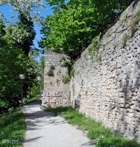

Walls
The surviving stretch of the ancient (albeit rebuilt) walls of Terni probably date to ca. 270 BC. These walls were not polygonal, like those of Spoletium, but of large squared blocks of travertine carefully faced and cut to Roman measures. Many of these blocks were reused and can still be seen in the long stretches of wall in:
-
✴Via delle Mura; and
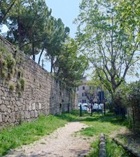
The walls were rebuilt, probably in the 13th century, essentially following the Roman circuit, and a new canal, the forma nova, was cut beyond them to enclose the suburb that had developed to the north. The walls were rebuilt again in ca. 1354, as part of the defenses put in place by Cardinal Gil Albornoz: this circuit was again largely built on the Roman foundations, although it departed in the northern sector as far as the forma nova.
-
✴The church of San Nicolò near Porta San Giovanni, which was documented as “foris portam” or variants thereof in the period 1275 - 1372, is referred to in later documents (from 1429) as “inter portas”, which suggests that it was enclosed by the new circuit.
-
✴The Convento di San Francesco, which had probably been outside the older walls, was certainly inside the new ones.
Taxes were raised for the upkeep of the walls in 1388 and on a number of subsequent occasions in the 15th century. The circuit had some 30 towers by the 17th century. However, it had become obsolete for defensive purposes by the 18th century and began to deteriorate. A section of the walls near Porta Romana (see below) was demolished in 1785 and the most of the rest followed in the late 19th and early 20th centuries. Most of the forma nova was filled in in 1950.
Gates
The Roman city had the conventional layout, with the orthogonal cardo maximus (Via Flaminia) and decumanus maximus intersecting at the forum. There were certainly at least four gates in the Roman circuit, one at each end of each of these thoroughfares, near the gates that were later known as:
-
✴Porta Sant’ Angelo, to the west;
-
✴Porta Romana, to the south;
-
✴Porta del Sesto, to the east; and
-
✴Porta San Giovanni, to the north east.
These gates were rebuilt in ca. 1354, and a fifth, Porta Spoletina, was added to the north.
Porta Sant’ Angelo (ca. 1354)
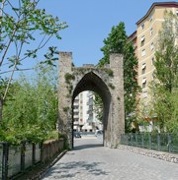
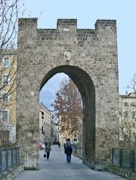
This well-preserved gate probably stands on the site of the Roman gate that marked the west end of the decumanus maximus (now Corso Cavour). Views of Terni from the 17th century show a double gate here, of which only the outer arch survives. A series of modifications are documented in the 18th century, and further modifications occurred in the 19th century, when the area outside the walls was first developed. The gate was extensively restored after the bombardment of the Second World War. Traces of the adjoining Roman wall were found along Via della Rinascita when the underground car park here was built (to the right as you leave the city).
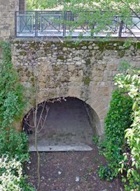
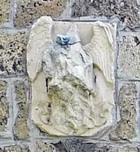
Porta Romana
A spur from Via Flaminia entered the Roman city from the south through a gate that was known (at least by the Middle Ages) as Porta Romana. This gate, which marked the southern end of the cardo maximus (now Via Roma), probably stood at the point where modern Viale del Cassero joins Piazza Briccialdi. The gate was probably rebuilt and fortified in ca. 1354, when the Cassero was built outside it.
Reliefs (1449) of the arms of Terni and of Pope Nicholas V, which commemorated the papal visit to the city in that year, were removed from Porta Romana in 1640 and are now in the Civic Lapidiary Collection: the gate was rebuilt in that year and decorated with the arms of Pope Urban VIII. This gate was demolished in 1855 to improve the flow of traffic in what became Piazza Briccialdi.
Porta del Sesto
The Roman gate at the east end of the decumanus maximus (modern Via Garibaldi) probably stood on the site of medieval Porta del Sesto, which seems to have been near the junction of Via Garibaldi with Via delle Conce and Via San Nicandro. The gate, like the nearby bridge (see below), was named for Sextus Pompeius, although it later became known as Porta Garibaldi. It had been replaced by a customs barrier by the 1930s and no trace of it now survives.
Porta San Giovanni
The Roman gate at the north east end of the cardo maximus probably stood in Piazza Corona. Its successor must have been demolished when the new walls were built slightly to the east in ca. 1354. The new gate that was built to accommodate the existing road network was known as Porta San Giovanni; the nearby church of San Giovanni was described as ancient in the 17th century. No trace survives of either the gate or the church: a reminder of them is preserved in the name of Via Porta San Giovanni, which runs east from Piazza Corona.
Porta Spoletina (ca. 1354)
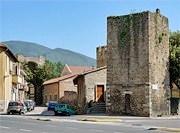
This gate was built to the north of Porta San Giovanni in the new walls (ca. 1354). It was also known as the Porta Tre Monument, in reference to the three Roman funerary monuments in what is now known as the Piazza Tre Monumenti, which were demolished in 1568. It led to the “pontem Trium Monumentorum” (the bridge of the three monuments), which crossed the forma nova until this canal was filled in in 1950.
Like Porta Sant’ Angelo, Porta Spoletina seems to have originally been a double gate, of which only the outer arch survives. Two associated towers in the adjacent walls also survive. In 1890, these vestiges were incorporated into a new factory that was known as the Officine Bosco.
Bridges over the Nera
Ponte di Sant’ Antonio
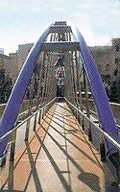
The Commune commissioned a new stone bridge on the site in 1392-5. This new bridge had defensive towers at each end and was linked by a wall to the Cassero. Traffic entering the city here: first crossed the fortified bridge; then twice crossed the moat as it entered and then left the Cassero; before finally passing through Porta Romana. After the demolition of the Cassero in 1442, a wall linked the bridge directly to Porta Romana.
Ponte Sant’ Antonio was badly damaged by floods in 1500 and again in 1550, and was then replaced by a temporary wooden structure. Giacomo Barozzi da Vignola designed a more permanent structure in 1569, but it continued to cause problems. Alessandro Fontana worked on it in 1598 in preparation for a visit by Pope Clement VIII. (He was en route for Ferrara, which he had seized after the death of Duke Alfonso II d’ Este). An early Christian inscription that is now in the Civic Lapidiary Collection had been reused to record (on the opposite side) the restoration of the bridge by Clement VIII in 1599. Alessandro Fontana did further work on it in 1600 but problems persisted. It was demolished in 1605 and replaced by Ponte Romano, on a site slightly to the west.
Ponte Romano
Domenico Fontana was appointed to build this new bridge, which Pope Paul V inaugurated in 1611. The arms of Paul V appear on the bridge. Two inscriptions [where are they ??] record that the people of Terni replaced the original, which was ruined by age at their own expense and named the new bridge Ponte Paolo in his honour. (This website by Mario Scipioni contains more information and illustrations].
This bridge was rebuilt after the bombardment of the Second World War.
Ponte del Sesto
In his “Storia di Terni” (1646), Francesco Angeloni described an inscription (now lost) that recorded that a bridge here had been destroyed in a flood in 1598, and that Clement VIII laid the foundations of its successor in 1602. It was rebuilt after the bombardment of the Second World War.
The Clementine inscription said that the original bridge on the site had been built by Sextus Pompeius, son of Gnaeus. This information was presumably based on another lost inscription from the Roman period. Angeloni probably thought that it referred to the youngest son of Gnaeus Pompeius Magnus (Pompey the Great), but this Sextius Pompeius was an outlaw throughout his adult life, most of which was spent outside Italy. Our Sextus Pompeius was more probably a relative of Aulus Pompeius, son of Aulus, who is described as a patron of the municipium in an inscription (CIL IX 4213) from the 1st century BC that is now in the Museo Archeologico.
